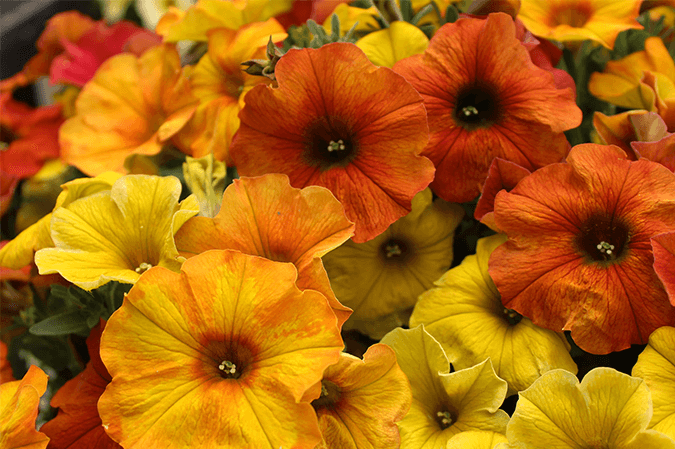Description
Petunias are a genus of flowering plants in the family Solanaceae, native to South America. The genus contains about 20 species, but the most commonly cultivated petunias are hybrids derived from Petunia axillaris and Petunia integrifolia. Petunias are popular for their vibrant and diverse colors, which range from white and pink to red, purple, blue, and bi-colored varieties. They are widely grown as annuals in gardens, containers, and hanging baskets, valued for their long blooming season and ease of care.
Common Features
- Leaves: Petunia leaves are usually soft, slightly sticky, and covered with fine hairs. They are typically oval-shaped and arranged alternately on the stem. The leaves are green, though the exact shade can vary depending on the variety and growing conditions.
- Flowers: The flowers of petunias are trumpet-shaped with five fused petals, creating a wide, open bloom. They can range in size from 1 to 4 inches in diameter, depending on the variety. Petunia flowers come in a wide array of colors, including solid, striped, and speckled patterns. Some varieties are also fragrant, particularly in the evening.
- Growth Habit: Petunias are low-growing plants, usually reaching heights of 6 to 18 inches. They can spread up to 2 feet or more, making them excellent for ground cover or spilling over the edges of containers. There are several types of petunias, including grandiflora (large flowers), multiflora (smaller but more numerous flowers), and milliflora (tiny flowers).
- Fragrance: While not all petunias are fragrant, certain varieties, such as Petunia axillaris, emit a sweet scent, especially in the evening. This fragrance can attract night-flying pollinators like moths.
Role in the Ecosystem
- Pollinator Attraction: Petunias play a crucial role in attracting pollinators, including bees, butterflies, and hummingbirds. The bright colors and sometimes sweet fragrance of petunias are highly attractive to these creatures, aiding in the pollination process. Evening-fragrant varieties are particularly attractive to nocturnal pollinators such as moths.
- Ground Cover: Petunias can be used as ground cover in garden beds, helping to protect the soil from erosion. Their dense growth habit also helps to suppress weeds, contributing to healthier garden ecosystems.
- Biodiversity Support: By providing nectar and pollen, petunias support a range of insects and other small wildlife, contributing to local biodiversity. In turn, these pollinators help to sustain the plant populations in the area.
Importance
- Ornamental Value: Petunias are one of the most popular ornamental plants worldwide, known for their vivid colors, diverse patterns, and long blooming period. They are commonly used in gardens, hanging baskets, window boxes, and containers, providing a burst of color throughout the growing season. Their versatility in landscape design makes them a favorite among gardeners.
- Cultural Significance: In the language of flowers, petunias symbolize anger and resentment, but they can also represent comfort and the desire to spend time with someone because of their welcoming appearance. Despite the mixed symbolism, their beauty makes them a popular choice for gifts and decorations.
- Ease of Cultivation: Petunias are relatively easy to grow, requiring only basic care such as regular watering, deadheading, and occasional feeding. They are adaptable to various growing conditions, making them an excellent choice for beginner gardeners.
- Economic Importance: The cultivation and sale of petunias are significant in the horticultural industry. They are among the most widely sold bedding plants in nurseries and garden centers, contributing to the global floriculture market. Their popularity as ornamental plants drives significant economic activity in the gardening and landscaping sectors.
Interesting Facts
- Hybrid Development: The petunias commonly found in gardens today are the result of extensive hybridization, which has led to a wide range of flower colors, sizes, and growth habits. The first hybrid petunia, Petunia × atkinsiana, was developed in the 19th century.
- Night Blooms: Some species of petunias, such as Petunia axillaris, have flowers that open in the evening and emit a strong fragrance to attract night-flying pollinators like moths.
- Space Travel: Petunias were one of the first plants to be grown in space as part of NASA’s experiments on plant growth in microgravity. This research has contributed to our understanding of how plants can be cultivated in space environments.
Sources
- Missouri Botanical Garden. (n.d.). Petunia – Plant Finder. Retrieved from MBG
- Royal Horticultural Society. (n.d.). Petunia – Growing Guide. Retrieved from RHS
- University of Florida, IFAS Extension. (n.d.). Petunia – Care and Cultivation. Retrieved from UF IFAS Extension
- NASA. (2017). Petunias in Space: How Microgravity Affects Plant Growth. Retrieved from NASA



